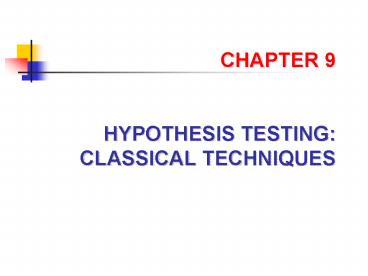CHAPTER 9 HYPOTHESIS TESTING: CLASSICAL TECHNIQUES - PowerPoint PPT Presentation
1 / 31
Title:
CHAPTER 9 HYPOTHESIS TESTING: CLASSICAL TECHNIQUES
Description:
Null Hypothesis - a description of what people have long believed to be true ... Confidence Level of the Hypothesis Test - the probability of accepting the null ... – PowerPoint PPT presentation
Number of Views:285
Avg rating:3.0/5.0
Title: CHAPTER 9 HYPOTHESIS TESTING: CLASSICAL TECHNIQUES
1
CHAPTER 9HYPOTHESIS TESTING CLASSICAL
TECHNIQUES
2
Introduction
- A. Hypothesis - a proposition (some belief about
reality) tentatively advanced as possibly true - B. Hypothesis Testing - a systematic approach to
assessing tentative beliefs about reality it
involves confronting those beliefs with evidence
and deciding whether the beliefs can be
maintained as reasonable or must be discarded as
untenable.
3
4 Major Steps
- Step 1 Formulating 2 Opposing Hypotheses
- A. Null Hypothesis - a description of what
people have long believed to be true (status quo,
conventional wisdom)
- B. Alternative Hypothesis - new claim that
contradicts the null hypothesis (conventional
wisdom)
4
- C. Exact Hypothesis - a null hypothesis that
specifies a single value for the unknown parameter
5
- D. Inexact Hypothesis - an alternative hypothesis
that specifies a range of values for the unknown
parameter
6
- E. Two-sided Hypothesis - an alternative
hypothesis that holds for deviations from the
null hypothesis in either direction
7
- F. One-sided Hypothesis - an alternative
hypothesis that holds for deviations from the
null hypothesis in one direction only
8
- Step 2 Selecting a Test Statistic
- Test Statistic a statistic computed from a
simple random sample taken from the population of
interest in a hypothesis test and then used for
establishing the probable truth or falsity of the
null hypothesis
9
Statistics Commonly Used for Tests About a
Population Mean
10
Statistics Commonly Used for Tests About a
Population Mean
11
- Step 3 Deriving a Decision Rule
- A. Decision Rule - a hypothesis testing rule that
specifies in advance, for all possible values of
a test statistic that might be computed from a
sample, whether the null hypothesis should be
accepted or whether it should be rejected in
favor of the alternative hypothesis
12
- B. Acceptance Region numerical values of the
test statistic for which the null hypothesis is
accepted lie here
13
- C. Rejection Region - numerical values of the
test statistic for which the null hypothesis is
rejected lie here
14
- D. Statistically Significant - numerical values
of the test statistic for which the null
hypothesis is rejected are considered
- E. Not Statistically Significant - numerical
values of the test statistic for which the null
hypothesis is accepted are considered
15
- F. Significance Level (size of a hypothesis test)
- the (arbitrary) maximum proportion of all
sample results that are possible that is
considered sufficiently unusual to reject the
null hypothesis when the null hypothesis is true
(symbolized by alpha)
16
- G. Critical Value (cutoff point or acceptance
number) - value of a test statistic that divides
all possible values into an acceptance and
rejection region
17
- H. Two-tailed Test - when the alternative
hypothesis is two-sided
18
- I. One-tailed Test - when the alternative
hypothesis is one-sided
19
- J. Lower-tailed Test - entire rejection region is
in the lower tail
20
- K. Upper-tailed Test - entire rejection region is
in the upper tail
21
- Step 4 Taking a Sample, Computing the Test
Statistic, and Confronting It with the Decision
Rule
- A. Type I Error (Error of Rejection) - the
rejection of a true null hypothesis
- B. Alpha Risk - the probability of making a Type
I Error
- C. Confidence Level of the Hypothesis Test - the
probability of accepting the null hypothesis when
the null hypothesis is true
22
- D. Type II Error (Error of Acceptance) - the
acceptance of a false null hypothesis
- E. Beta Risk - the probability of making a Type
II Error
- F. Power of the Hypothesis Test - the probability
of rejecting the null hypothesis when the null
hypothesis is false
23
TABLE 9.3 Evaluating the Outcome of a
Hypothesis Test
24
FIGURE 9.3 - The Trade-Off Between Type I and
Type II Error
25
CAUTION
26
VI. Large-Sample Tests of a Population Mean
- A. 2-Tail Test
27
(No Transcript)
28
- B. Lower-Tail Test
29
(No Transcript)
30
- VII. Small-Sample Tests of a Population Mean
- A. Upper-Tail Test
31
(No Transcript)































